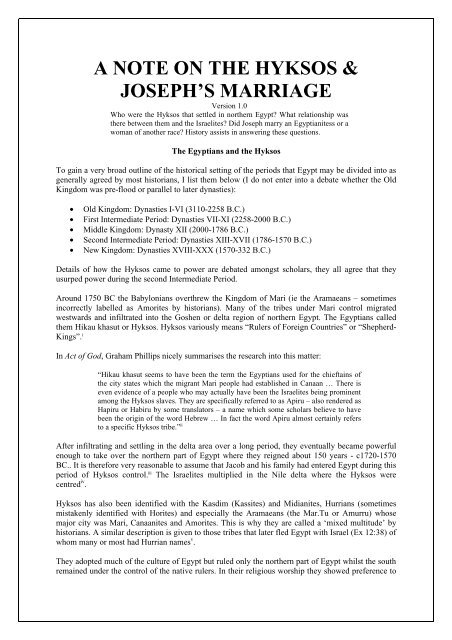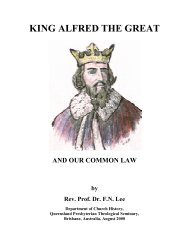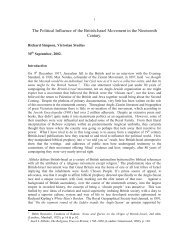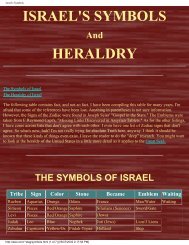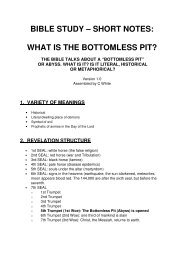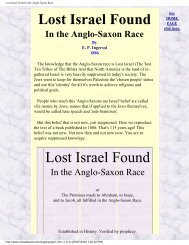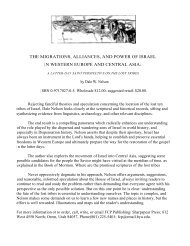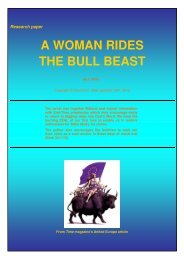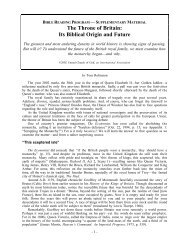a note on the hyksos & joseph's marriage - Origin of Nations
a note on the hyksos & joseph's marriage - Origin of Nations
a note on the hyksos & joseph's marriage - Origin of Nations
You also want an ePaper? Increase the reach of your titles
YUMPU automatically turns print PDFs into web optimized ePapers that Google loves.
A NOTE ON THE HYKSOS &<br />
JOSEPH’S MARRIAGE<br />
Versi<strong>on</strong> 1.0<br />
Who were <strong>the</strong> Hyksos that settled in nor<strong>the</strong>rn Egypt What relati<strong>on</strong>ship was<br />
<strong>the</strong>re between <strong>the</strong>m and <strong>the</strong> Israelites Did Joseph marry an Egyptianitess or a<br />
woman <strong>of</strong> ano<strong>the</strong>r race History assists in answering <strong>the</strong>se questi<strong>on</strong>s.<br />
The Egyptians and <strong>the</strong> Hyksos<br />
To gain a very broad outline <strong>of</strong> <strong>the</strong> historical setting <strong>of</strong> <strong>the</strong> periods that Egypt may be divided into as<br />
generally agreed by most historians, I list <strong>the</strong>m below (I do not enter into a debate whe<strong>the</strong>r <strong>the</strong> Old<br />
Kingdom was pre-flood or parallel to later dynasties):<br />
• Old Kingdom: Dynasties I-VI (3110-2258 B.C.)<br />
• First Intermediate Period: Dynasties VII-XI (2258-2000 B.C.)<br />
• Middle Kingdom: Dynasty XII (2000-1786 B.C.)<br />
• Sec<strong>on</strong>d Intermediate Period: Dynasties XIII-XVII (1786-1570 B.C.)<br />
• New Kingdom: Dynasties XVIII-XXX (1570-332 B.C.)<br />
Details <strong>of</strong> how <strong>the</strong> Hyksos came to power are debated am<strong>on</strong>gst scholars, <strong>the</strong>y all agree that <strong>the</strong>y<br />
usurped power during <strong>the</strong> sec<strong>on</strong>d Intermediate Period.<br />
Around 1750 BC <strong>the</strong> Babyl<strong>on</strong>ians overthrew <strong>the</strong> Kingdom <strong>of</strong> Mari (ie <strong>the</strong> Aramaeans – sometimes<br />
incorrectly labelled as Amorites by historians). Many <strong>of</strong> <strong>the</strong> tribes under Mari c<strong>on</strong>trol migrated<br />
westwards and infiltrated into <strong>the</strong> Goshen or delta regi<strong>on</strong> <strong>of</strong> nor<strong>the</strong>rn Egypt. The Egyptians called<br />
<strong>the</strong>m Hikau khasut or Hyksos. Hyksos variously means “Rulers <strong>of</strong> Foreign Countries” or “Shepherd-<br />
Kings”. i<br />
In Act <strong>of</strong> God, Graham Phillips nicely summarises <strong>the</strong> research into this matter:<br />
“Hikau khasut seems to have been <strong>the</strong> term <strong>the</strong> Egyptians used for <strong>the</strong> chieftains <strong>of</strong><br />
<strong>the</strong> city states which <strong>the</strong> migrant Mari people had established in Canaan … There is<br />
even evidence <strong>of</strong> a people who may actually have been <strong>the</strong> Israelites being prominent<br />
am<strong>on</strong>g <strong>the</strong> Hyksos slaves. They are specifically referred to as Apiru – also rendered as<br />
Hapiru or Habiru by some translators – a name which some scholars believe to have<br />
been <strong>the</strong> origin <strong>of</strong> <strong>the</strong> word Hebrew … In fact <strong>the</strong> word Apiru almost certainly refers<br />
to a specific Hyksos tribe.” ii<br />
After infiltrating and settling in <strong>the</strong> delta area over a l<strong>on</strong>g period, <strong>the</strong>y eventually became powerful<br />
enough to take over <strong>the</strong> nor<strong>the</strong>rn part <strong>of</strong> Egypt where <strong>the</strong>y reigned about 150 years - c1720-1570<br />
BC.. It is <strong>the</strong>refore very reas<strong>on</strong>able to assume that Jacob and his family had entered Egypt during this<br />
period <strong>of</strong> Hyksos c<strong>on</strong>trol. iii The Israelites multiplied in <strong>the</strong> Nile delta where <strong>the</strong> Hyksos were<br />
centred iv .<br />
Hyksos has also been identified with <strong>the</strong> Kasdim (Kassites) and Midianites, Hurrians (sometimes<br />
mistakenly identified with Horites) and especially <strong>the</strong> Aramaeans (<strong>the</strong> Mar.Tu or Amurru) whose<br />
major city was Mari, Canaanites and Amorites. This is why <strong>the</strong>y are called a ‘mixed multitude’ by<br />
historians. A similar descripti<strong>on</strong> is given to those tribes that later fled Egypt with Israel (Ex 12:38) <strong>of</strong><br />
whom many or most had Hurrian names v .<br />
They adopted much <strong>of</strong> <strong>the</strong> culture <strong>of</strong> Egypt but ruled <strong>on</strong>ly <strong>the</strong> nor<strong>the</strong>rn part <strong>of</strong> Egypt whilst <strong>the</strong> south<br />
remained under <strong>the</strong> c<strong>on</strong>trol <strong>of</strong> <strong>the</strong> native rulers. In <strong>the</strong>ir religious worship <strong>the</strong>y showed preference to
certain deities such as Set, but <strong>the</strong>y did not suppress <strong>the</strong> o<strong>the</strong>r gods. “The title given to Joseph’s<br />
fa<strong>the</strong>r-in-law, priest <strong>of</strong> On, is interesting. On is <strong>the</strong> Egyptian city … Heliopolis … <strong>the</strong> centre <strong>of</strong><br />
worship <strong>of</strong> <strong>the</strong> sun god Re”. vi Whe<strong>the</strong>r this priest was a priest <strong>of</strong> Re or <strong>the</strong> preferred Hyksos deity,<br />
Set, is not known.<br />
It seems that it was a Hyksos m<strong>on</strong>arch whom Joseph became an interpreter <strong>of</strong> dreams (Gen 41:14-37)<br />
and who ceded land to Joseph in Goshen (Gen 47:6). As such, <strong>the</strong> new king menti<strong>on</strong>ed in Ex 1:8<br />
would have been a native Egyptian m<strong>on</strong>arch <strong>of</strong> <strong>the</strong> New Kingdom. He would have reversed <strong>the</strong><br />
validity <strong>of</strong> any land claims by <strong>the</strong> Israelites and o<strong>the</strong>rs.<br />
Customs <strong>of</strong> Joseph’s experiences are related to <strong>the</strong> Hyksos: eg <strong>the</strong> chariot (unknown in Egypt until<br />
<strong>the</strong> appearance <strong>of</strong> <strong>the</strong>se Asiatics), <strong>the</strong> ring and <strong>the</strong> way <strong>of</strong> treating <strong>the</strong> Pharoah are Hyksos customs. vii<br />
(The term used for "overseers" that Joseph uses when talking to Pharaoh is an Aramaic title).<br />
The Hyksos peoples, from all accounts, were very innovative – <strong>the</strong>se innovati<strong>on</strong>s were to prove very<br />
useful in later <strong>on</strong> in Egyptian history. The Atlas <strong>of</strong> Ancient Egypt summarises <strong>the</strong>se:<br />
“Until this time Egypt had been technologically backward in comparis<strong>on</strong> to with <strong>the</strong><br />
Near East … Am<strong>on</strong>g <strong>the</strong> new techniques were br<strong>on</strong>zeworking … an improved potters<br />
wheel and <strong>the</strong> vertical loom; hum-backed cattle (zebu) and new vegetable and fruit<br />
crops; <strong>the</strong> horse and chariot, composite bows, and new shapes <strong>of</strong> scimitar and o<strong>the</strong>r<br />
weap<strong>on</strong>s … new musical instruments … and … dances”. viii<br />
According to The Pentateuch in Its Cultural Envir<strong>on</strong>ment,<br />
“Coming from <strong>the</strong> nor<strong>the</strong>ast, <strong>the</strong> Hyksos were basically Semitic, but <strong>the</strong>ir leaders<br />
seemed to be Aryans, and possibly some Hurrians. Manetho describes <strong>the</strong>m as savage<br />
destroyers. He called <strong>the</strong>m “Shepherd Kings,” but in Egyptian <strong>the</strong> name means “rulers<br />
<strong>of</strong> foreign lands”.<br />
The Hyksos c<strong>on</strong>quered Egypt about 1720 B.C. They so<strong>on</strong> put Semites in <strong>of</strong>ficial<br />
positi<strong>on</strong>s and seemed to have some kind <strong>of</strong> relati<strong>on</strong>ship with <strong>the</strong> Habiru, or<br />
Apiru/Aperu in <strong>the</strong> Egyptian language. Two <strong>of</strong> <strong>the</strong> Hyksos leaders had <strong>the</strong> names<br />
Jacob-el and Jacob-baal. Joseph and <strong>the</strong> migrati<strong>on</strong> <strong>of</strong> Jacob’s family to Egypt may<br />
have taken place early during <strong>the</strong> Hyksos rule <strong>of</strong> Egypt”. ix [emphasis mine]<br />
O<strong>the</strong>r scholars <str<strong>on</strong>g>note</str<strong>on</strong>g> that name Jaqob-bar (a name akin to Jacob) was a fairly comm<strong>on</strong> name <strong>of</strong> <strong>the</strong><br />
Hyksos period x which gives fur<strong>the</strong>r credence to <strong>the</strong> relati<strong>on</strong>ship between <strong>the</strong> Israelites and<br />
Aramaeans.<br />
Cyrus Gord<strong>on</strong> in The Ancient Near East:<br />
“The Hyksos hordes included Indo-European warriors [an Aryan ethnic group which<br />
included Hittites and Mitanni in <strong>the</strong> Near East]. With <strong>the</strong> Indo-Europeans <strong>the</strong> horse,<br />
effectively used for pulling <strong>the</strong> war chariot, entered <strong>the</strong> Near East and revoluti<strong>on</strong>ized<br />
<strong>the</strong> art <strong>of</strong> warfare. The Iranian plateau was to become a great stamping ground <strong>of</strong> <strong>the</strong><br />
Aryans (as we may call <strong>the</strong> segment <strong>of</strong> <strong>the</strong> Indo-Europeans to which <strong>the</strong> Iranians<br />
bel<strong>on</strong>g).” xi [emphasis mine]<br />
So, from this we may deduce that <strong>the</strong> ruling class and many <strong>of</strong> <strong>the</strong> peoples comprising <strong>the</strong> Hyksos<br />
were European in racial stock (ie called Indo-European or Aryan by historians).<br />
Because <strong>the</strong>y were unable to quell Egyptian nati<strong>on</strong>alistic feelings, <strong>the</strong> Hyksos formed an alliance<br />
with <strong>the</strong> Nubian Kingdom <strong>of</strong> Kush to c<strong>on</strong>tain <strong>the</strong> Egyptians. Even so, <strong>the</strong> city <strong>of</strong> Thebes in sou<strong>the</strong>rn<br />
Egypt commenced a war which resulted in <strong>the</strong> expulsi<strong>on</strong> <strong>of</strong> <strong>the</strong> Hyksos by Ahmose I. xii (Moses is a<br />
form <strong>of</strong> Ahmose)
Who were <strong>the</strong> Hyksos Apiru<br />
The Bible and secular history make menti<strong>on</strong> <strong>of</strong> a people called <strong>the</strong> Apiru, Khabiru, Hapiru or<br />
Hebrews who were in <strong>the</strong> Middle East prior to <strong>the</strong> Exodus. Who were <strong>the</strong>y <br />
Let us first notice <strong>the</strong> pertinent scriptures :<br />
“Moreover <strong>the</strong> Hebrews that were with <strong>the</strong> Philistines before that time ... turned to<br />
be with <strong>the</strong> Israelites” (I Sam. 14:21).<br />
“And J<strong>on</strong>athan smote <strong>the</strong> garris<strong>on</strong> <strong>of</strong> <strong>the</strong> Philistines that was in Geba, and <strong>the</strong><br />
Philistines heard <strong>of</strong> it. And Saul blew <strong>the</strong> trumpet, throughout all <strong>the</strong> land, saying,<br />
‘Let <strong>the</strong> Hebrews hear' ...<br />
“And some <strong>of</strong> <strong>the</strong> Hebrews went over Jordan to <strong>the</strong> land <strong>of</strong> Gad and Gilead” (I Sam.<br />
13:3,7).<br />
These are not Israelite Hebrews, but different Hebrews altoge<strong>the</strong>r xiii<br />
grands<strong>on</strong> <strong>of</strong> Arphaxad. xiv<br />
who descend from Eber,<br />
They are first menti<strong>on</strong>ed c.2000 BC where <strong>the</strong>y are found wandering all over <strong>the</strong> Near East: Alakh,<br />
Amarna, Boghazkoy, Babyl<strong>on</strong>, Larsa, Mari, Nuzi, Ugarit and Palestine. The Khabiru appear to have<br />
been mercenaries fighting for <strong>the</strong> Hittites and Hurrians xv . There was even a valley <strong>of</strong> Habur between<br />
Euphrates and <strong>the</strong> Tigris. Ethnically <strong>the</strong>y were Indo-Europeans <strong>of</strong> <strong>the</strong> same stock as <strong>the</strong> Hittites and<br />
<strong>the</strong> Hurrians xvi . Apparently <strong>the</strong>y were c<strong>on</strong>centrated in <strong>the</strong> general area from where Abram came<br />
from xvii - Nor<strong>the</strong>rn Syria/Nor<strong>the</strong>rn Mesopotamia xviii . Many <strong>of</strong> <strong>the</strong>ir names are Hurrian (Indo-<br />
European), and being with <strong>the</strong> Hurrians may be <strong>the</strong> reas<strong>on</strong> for Palestine being known as “<strong>the</strong> land <strong>of</strong><br />
Huru” xix .<br />
Later, many <strong>of</strong> <strong>the</strong>m were allies <strong>of</strong> <strong>the</strong> Aramaeans and helped <strong>the</strong>m rule nor<strong>the</strong>rn Egypt as we have<br />
seen.<br />
This is what we are told:<br />
Did Joseph marry an Egyptianitess<br />
“Gen 41:44 And Pharaoh said to Joseph, I am Pharaoh, and without a word from you, no<br />
man shall lift up his hand or foot in all <strong>the</strong> land <strong>of</strong> Egypt.<br />
Gen 41:45 And Pharaoh called Joseph's name Zaphnath-paaneah. And he gave him<br />
Asenath, <strong>the</strong> daughter <strong>of</strong> Potipherah, priest <strong>of</strong> On, for his wife. And Joseph went out<br />
over <strong>the</strong> land <strong>of</strong> Egypt.” (see also 46:20, 34)<br />
It does not state that she was an Egyptian at all. Now, given that On was in <strong>the</strong> Goshen area where<br />
<strong>the</strong> Hyksos and <strong>the</strong>ir aristocracy settled, it is reas<strong>on</strong>able to assume that he married into that stock for<br />
<strong>the</strong> Egyptians proper were driven southwards.<br />
Although her name is Egyptian, remember that most Black Americans, for example, have names <strong>of</strong><br />
Whites, so a name itself is not pro<strong>of</strong> for her being a Black Egyptian. Note Ex 2:16-19 where Moses is<br />
called an Egyptian for example.<br />
The Aramaeans were closely akin to <strong>the</strong> Hebrews. Aram is a s<strong>on</strong> <strong>of</strong> Shem (Genesis 10:22). The<br />
Israelites were even taught to say "A Syrian (Aramaean) ready to perish was my fa<strong>the</strong>r"<br />
(Deuter<strong>on</strong>omy 26:5). In Genesis 24 and 29 we find that <strong>the</strong> kinship <strong>of</strong> <strong>the</strong> Hebrews and Arameans<br />
was cemented by <strong>the</strong> <strong>marriage</strong> <strong>of</strong> Isaac with Rebekah, <strong>the</strong> sister Aramaean, Laban; and later <strong>of</strong> Jacob<br />
with his daughters. In IChr<strong>on</strong>icles 7:14 <strong>the</strong> Israelite Manasseh marries an Aramaean woman. This
dem<strong>on</strong>strates <strong>the</strong> ethnic closeness <strong>of</strong> <strong>the</strong> descendants <strong>of</strong> Arphaxad through <strong>the</strong> generati<strong>on</strong>s to<br />
Abraham, Isaac and Jacob, with <strong>the</strong> descendants <strong>of</strong> Aram.<br />
As we have seen, <strong>the</strong>re were fair Hyksos and Aramaeans (wr<strong>on</strong>gly translated as ‘Syrian’) living at<br />
<strong>the</strong> edge <strong>of</strong> Goshen, where <strong>the</strong> Israelites were later to dwell. After <strong>the</strong>y were expelled, <strong>the</strong> Egyptians<br />
turned <strong>on</strong> Israel. See Deut 26:4-8 where Jacob is called an Aramaean because <strong>of</strong> <strong>the</strong> close associati<strong>on</strong><br />
with <strong>the</strong>m (and <strong>the</strong> Hyksos).<br />
Why did Israel live in <strong>the</strong> area <strong>of</strong> Goshen and not fur<strong>the</strong>r south:<br />
Lev 20:24 “But I have said to you, You shall inherit <strong>the</strong>ir land, and I, I am giving it to<br />
you to possess it, a land that flows with milk and h<strong>on</strong>ey. I am Jehovah your God, who<br />
has separated you from <strong>the</strong> nati<strong>on</strong>s.” (compare Acts 17:26)<br />
It was under <strong>the</strong> Hyksos, ethnically related to Joseph, that he rose to prominence and his wife must<br />
have been <strong>of</strong> this stock xx . After <strong>the</strong> Hyksos were overthrown and expelled from Egypt, Israel fell<br />
from favour and was enslaved. Today <strong>the</strong> Khabiru are probably in nor<strong>the</strong>rn Europe, with o<strong>the</strong>r<br />
descendants <strong>of</strong> Abraham or nor<strong>the</strong>rn Germany or even perhaps Denmark. A prophecy in Numbers<br />
appears to suggest <strong>the</strong> possibility <strong>of</strong> Eber being located close to Assur xxi<br />
Suggested Reading<br />
Aling, CF (1981) Egypt and Bible History. From Earliest Times to 1000 B.C. Baker Book House,<br />
Michigan.<br />
Baines, J (1984) Atlas <strong>of</strong> Ancient Egypt. Phaiden Press, Oxford.<br />
Malek, J<br />
Bims<strong>on</strong>, JJ (1981) Redating <strong>the</strong> Exodus and C<strong>on</strong>quest. The Alm<strong>on</strong>d Press, Sheffield.<br />
Hallo, WW (1971) The Ancient Near East. A History. Harcourt Brace Jovanovich, San Diego.<br />
Simps<strong>on</strong>, WK<br />
Livingst<strong>on</strong>, GH (1974) The Pentateuch in Its Cultural Envir<strong>on</strong>ment. Baker Book House, Michigan.<br />
Pfeifer, CF (1966) Dicti<strong>on</strong>ary <strong>of</strong> Biblical Archaeology. The Biblical World. Pickering & Inglis,<br />
L<strong>on</strong>d<strong>on</strong>.<br />
Phillips, G (1998) Act <strong>of</strong> God. Pan Books, L<strong>on</strong>d<strong>on</strong>.<br />
Rohl, D (1995) A Test <strong>of</strong> Time. The Bible – From Myth to History. Arrow Books, L<strong>on</strong>d<strong>on</strong>.<br />
Stump, KW (1988) “Pharoahs <strong>of</strong> <strong>the</strong> Time <strong>of</strong> <strong>the</strong> Exodus”, Good News, March-April: 14-17.<br />
Wils<strong>on</strong>, I (1985) The Exodus Enigma. Weidenfeld and Nicols<strong>on</strong>, L<strong>on</strong>d<strong>on</strong>.<br />
GPO Box 864, Sydney, Australia 2001<br />
www.origin<strong>of</strong>nati<strong>on</strong>s.org<br />
No limitati<strong>on</strong> is placed up<strong>on</strong> reproducti<strong>on</strong> <strong>of</strong> this document except that it must be reproduced in its entirety<br />
without modificati<strong>on</strong> or deleti<strong>on</strong>s. The publisher's name and address, copyright notice and this message must be<br />
included. It may be freely distributed but must be distributed without charge to <strong>the</strong> recipient.<br />
End<str<strong>on</strong>g>note</str<strong>on</strong>g>s<br />
i David Rohl in his A Test <strong>of</strong> Time has a very interesting explanati<strong>on</strong>:<br />
“There is <strong>on</strong>e possible biblical reference to Egypt’s Hyksos oppressors and this occurs in <strong>the</strong> Psalms.
He (i.e. God) loosed <strong>the</strong> full heat <strong>of</strong> his anger, fury, rage and destructi<strong>on</strong> by sending evil angels against <strong>the</strong>m (i.e. <strong>the</strong><br />
Egyptians). [Psalm 78:49-50]<br />
… The correct Hebrew for ‘evil angels’ is malakhim-roim … The phrase ‘king-shepherds’ in Biblical Hebrew is malakheiroim!”<br />
(page 288)<br />
ii Phillips 1998: 190, 199, 200<br />
iii Harris<strong>on</strong> 1970: 114<br />
iv Roux 1982 : 248; Ex. 12:37; Gen. 47:6, 11<br />
v Wiseman: 1973 : 224<br />
vi Aling: 1981:46<br />
vii Livingst<strong>on</strong>: 1974: 153<br />
viii<br />
Baines and Malek 1984:42. Ian Wils<strong>on</strong> explains:<br />
“While <strong>the</strong> Egyptians had old-fashi<strong>on</strong>ed solid wood bows, and had been somewhat backward in<br />
metallurgy for <strong>the</strong> manufacture <strong>of</strong> battleaxes and <strong>the</strong> like, <strong>the</strong> Hyksos had not <strong>on</strong>ly <strong>the</strong> much<br />
more powerful composite bow but also better made, better designed weap<strong>on</strong>s <strong>of</strong> close combat<br />
and a revoluti<strong>on</strong>ary innovati<strong>on</strong> for striking terror into enemy foot-soldiers, <strong>the</strong> horse-drawn<br />
chariot”. viii<br />
ix Livingst<strong>on</strong>: 1974: 26. See alsoHallo & Simps<strong>on</strong> 1971: 251<br />
x Wils<strong>on</strong> 1985: 64<br />
xi Gord<strong>on</strong> 1965: 280<br />
xii See Stump 1988:14-17 and many o<strong>the</strong>r articles and books <strong>on</strong> <strong>the</strong> subject<br />
xiii Roux: 1982 : 221. Pfeiffer: 1966 : 223<br />
xiv Noorbergen: 1978 : 81; Wiseman: 1973 : XVIII; Gayre; 1973: 26; Cottrell: 1975 : 165<br />
xv Wiseman: 1973; 8-9; Gayre: 1973 : 26.<br />
xvi Douglas : 1972 : 511<br />
xvii Roux : 1982 : 221<br />
xviii Gayre: 1973 : 26, Roux : 1982 : 221.<br />
xix Wiseman: 1973 : 8-9, 225<br />
xx Gen. 46 : 20.<br />
xxi Num. 24:24


